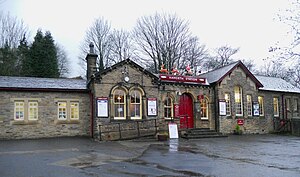Keighley and Worth Valley Railway
| Keighley and Worth Valley Railway | |
|---|---|
 |
|
 |
|
| Haworth Station | |
| Locale | West Yorkshire |
| Terminus | Oxenhope |
| Connections | Network Rail at Keighley |
| Commercial operations | |
| Name | Worth Valley Branch |
| Built by | K. & W. V. Rly Co. |
| Original gauge | 4 ft 8 1⁄2 in (1,435 mm) standard gauge |
| Preserved operations | |
| Owned by | Keighley & Worth Valley Preservation Society |
| Stations | 6 |
| Length | 5 mi (8 km) |
| Preserved gauge | 4 ft 8 1⁄2 in (1,435 mm) standard gauge |
| Commercial history | |
| Opened | 13 April 1867 |
| 1881 | Midland Railway takes over ownership of line |
| 1883 | Keighley Station opened in current location |
| 1884 | Great Northern Railway extended into Keighley via part of the Worth Valley Branch |
| 1892 | Mytholmes Tunnel built |
| 1923 | LMS takes over ownership / operation of line |
| 1948 | BR takes over ownership / operation of line |
| 1960 | Diesel Railcars introduced |
| Closed to passengers | 30 December 1961 |
| Closed | June 1962 |
| Preserved era | 1950s |
| Preservation history | |
| 1962 | Keighley and Worth Valley Railway Preservation Society formed |
| 1968 | Worth Valley Line reopened |
| 1971 | Damems loop built |
| Headquarters | Haworth |
| Website | |
| http://www.kwvr.co.uk/ | |
The Keighley and Worth Valley Railway is a 5-mile-long (8 km) branch line that served mills and villages in the Worth Valley and is now a heritage railway line in West Yorkshire, England. It runs from Keighley to Oxenhope. It connects to the national rail network at Keighley railway station.
In 1861, John McLandsborough, a civil engineer, visited Haworth to pay tribute to Charlotte Brontë and was surprised to find that it was not served by a railway. He put forward a proposal for a branch running from the station at Keighley to Oxenhope, which was warmly received by a number of mill owners and other influential people in the area as well as the Midland Railway, the owners of the railway through Keighley. The branch served 15 mills around its terminus as well as others on the line, and these were likely to be a source of traffic.
It was reported to the meeting of these local gentlemen that the line would cost £36,000 to build (equivalent to £3,030,000 in 2015). In light of this fact, 3,134 shares worth £10 each were issued at this meeting, along with the election of directors, bankers, solicitors and engineers. Notable was the fact that J McLandsborough, the original proposer of the line (who dealt predominantly with water and sewerage engineering, but had experience of building the Otley and Ilkley Railway) was appointed acting engineer; whilst J. S. Crossley of the Midland Railway was appointed consultant engineer.
The railway was incorporated by an Act of Parliament in 1862 and the first sod was cut on Shrove Tuesday, 9 February 1864 by Isaac Holden, the chairman of the Keighley and Worth Valley Railway.
The railway was built as single track, but with a trackbed wide enough to allow upgrading to double track if the need arose and the work was estimated to take approximately one year to complete. However, there were some delays: the time taken for the contractors to get possession of the land on which the railway was to be built; a cow eating the plans of the line somewhere near Oakworth; and, complications in digging the tunnel at the direct south end of Ingrow West. This manifested itself in that the tunnel walls, when bored, were oozing quicksand resulting in the application of piles being driven down to the bedrock to support and stabilise the tunnel. Unfortunately, this meant that the Wesley Place Methodist Church was damaged through the vibration and movement of the earth. The KWVR had to pay £1,980 in damages to the church.
...
Wikipedia
